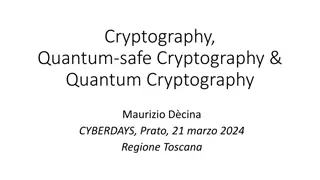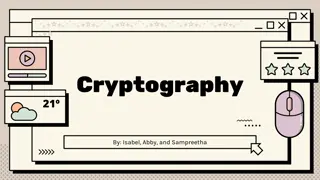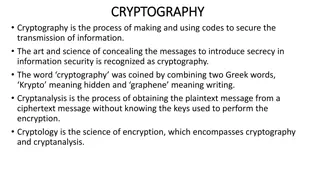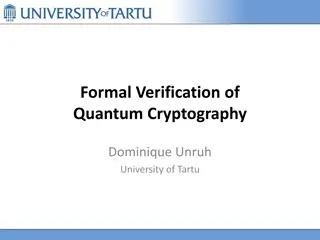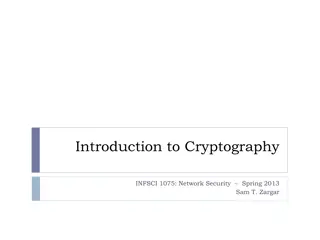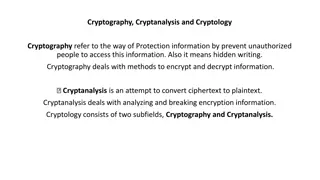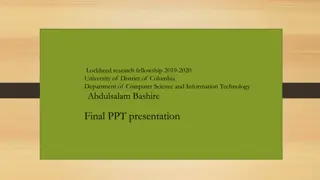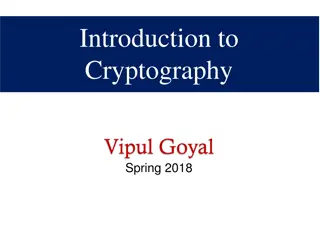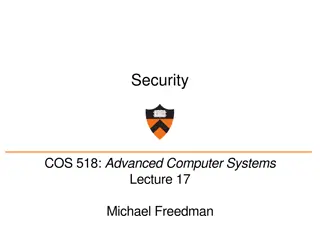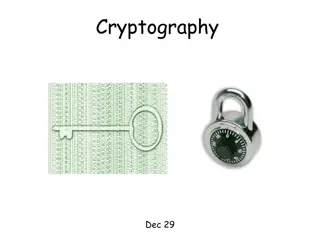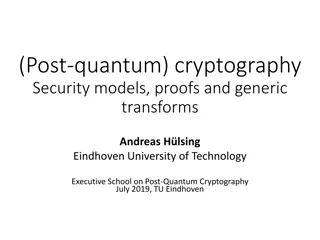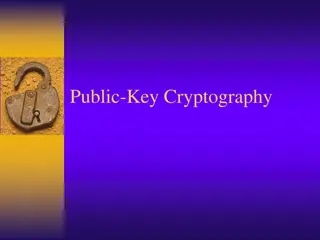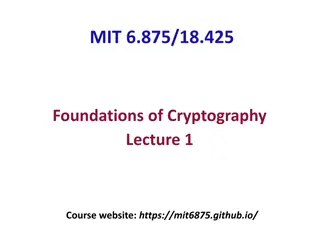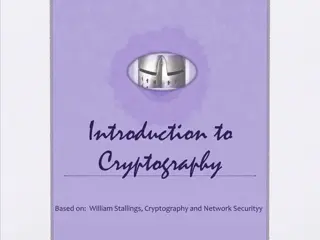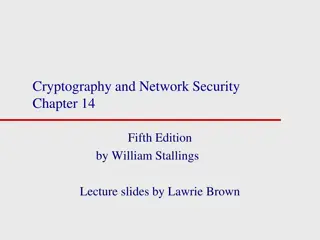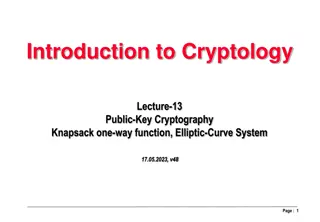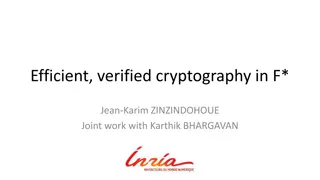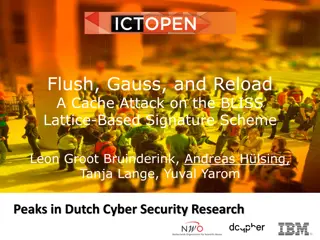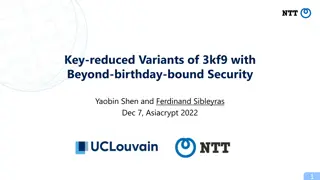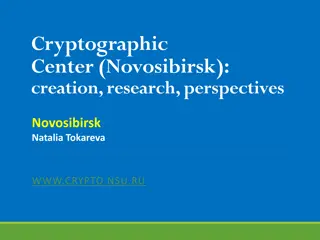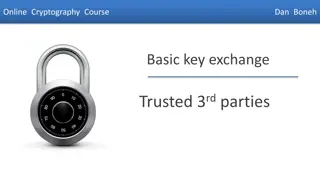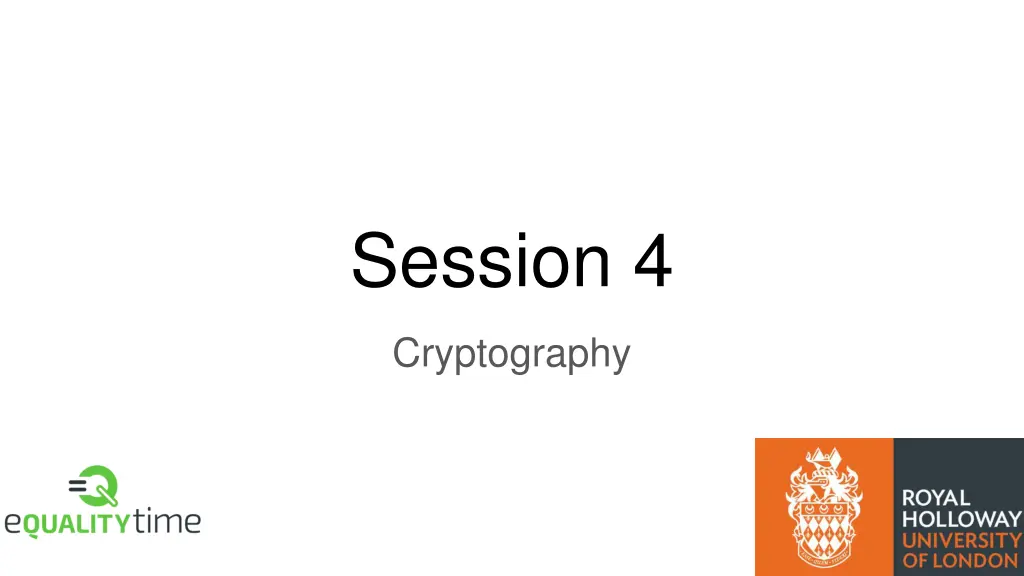
Exploring Cryptography: Security, History, and Modern Techniques
Learn about cryptography, its history, and how it plays a crucial role in ensuring security in today's world. Discover classical cryptography concepts, modern approaches, and the practical applications of encryption, digital signatures, and more. Understand how cryptography safeguards privacy, data integrity, and authentication in various domains such as electronic elections and digital commerce.
Download Presentation

Please find below an Image/Link to download the presentation.
The content on the website is provided AS IS for your information and personal use only. It may not be sold, licensed, or shared on other websites without obtaining consent from the author. If you encounter any issues during the download, it is possible that the publisher has removed the file from their server.
You are allowed to download the files provided on this website for personal or commercial use, subject to the condition that they are used lawfully. All files are the property of their respective owners.
The content on the website is provided AS IS for your information and personal use only. It may not be sold, licensed, or shared on other websites without obtaining consent from the author.
E N D
Presentation Transcript
Session 4 Cryptography
What we are going to learn today How to think about what security you want from a system What cryptography is about A bit of cryptography history What the modern approach to cryptography is
Have you ever voted for something? If yes, what for? If no, Have you elected a school rep? How do you decide who does the washing up? How do you decide where you want to go on holiday?
What do you expect from an election? Some things that might have come up.. You want your vote to be private - You want that only allowed people vote - You want everyone to only vote once - You want the result of the election to be truthful (and that your vote was counted!) - You want your vote to be recorded correctly - -
Cryptography can help with this!! You want your vote to be private ENCRYPTION - You want that only allowed people vote - CREDENTIALS/DIGITAL SIGNATURES You want everyone to only vote once - ZERO-KNOWLEDGE PROOFS You want the result of the election to be truthful (and that your vote was counted!) - VERIFIABLE COMPUTATION You want your vote to be recorded correctly - MESSAGE AUTHENTICATION PROTOCOLS -
Cryptography is pretty helpful indeed Why helpful? Helpful to whom? Cryptography in today s world A range of techniques for ensuring the confidentiality, integrity and origin of data. Used for mobile phones, chip and pin cards, Internet commerce, and more. A science, involving a blend of mathematics, statistics, computer science and engineering: Advanced encryption Digital signatures Key exchange primitives Secure multi-party computation Private information retrieval Electronic elections and auctions
Classical cryptography from me to you Historically: making (and breaking) codes and ciphers Designed to scramble messages so they cannot be read by an enemy. KEY IDEA in classical crypto A sender wants to transmit information to a receiver securely, i.e., only the sender and the intended receiver should be able to recover the information. This is achieved by means of encryption.
The most famous cipher of them all In the 1stcentury BC, a new cipher appeared. It became known as Caesar s cipher, since Julius Caesar was one of its most famous users. IDEA: Each letter of the message was substituted by one three positions further down the alphabet. So A becomes ? And B becomes ?
The Caesar Cipher Message: YES 24 4 18 Encrypted message is A 0 N 13 14 15 16 17 18 19 20 21 22 23 24 25 B 1 O C 2 P D 3 Q E 4 R F 5 S G 6 T H 7 U I 8 V J 9 W K 10 11 12 X Y L M Z Would you use this cipher? (it depends, but probably no..) TAKEAWAY 1: You need many keys.
Substitution cipher Pick a random one-to-one mapping of the letters of the alphabet. A B C D E F G H I J K L M N O P Q R S T U V W X Y Z L Y N B R G M T Z S C O A W K F I X P V D Q U H J E So the encryption of TUESDAY would be VDRPBLJ. What would RLPJ decrypt to? How many keys now? The number of keys is very large: 26! 4 1026 Would you use this cipher?
How frequent are you? MAIN INSIGHT: If we know what language an encrypted message belongs to, we can analyse a message written in the same language, and count how many times each letter appears. We can rank letters in order of frequency, and map these to the ranking we perform on the encrypted message. A 8.17% H 6.09% O 7.51% V 0.98% For example, in the English language B 1.49% I 6.97% P 1.93% W 2.36% C 2.78% 0.15% Q 0.10% 0.15% J X Top letters are E, T, A and O. The same can be done with digrams (TH, HE, IN, ) and trigrams (THE, ING, AND, ). D 4.25% K 0.77% R 5.99% Y 1.97% 12.70% L 4.03% S 6.33% Z 0.07% E 2.29% M 2.41% T 9.06% F G 2.02% N 6.75% U 2.76%
Mono vs poly TAKEAWAY 2: Many keys is not enough. In the ciphers we have seen so far, once the key is chosen, each plaintext character is mapped to a unique ciphertext character. For this reason, these ciphers are called monoalphabetic. For these types of ciphers, frequency analysis works very well. Designers of ciphers realized they needed to break that unique mapping in order to try and resist frequency analysis. This led to the introduction of polyalphabetic ciphers.
Le chiffre indechiffrable Blaise de Vigenere, in the XVI century, created the most famous polyalphabetic cipher, which became known as le chiffre indechiffrable, since it took over 300 years to break it. Map letters to numbers, as usual. Choose a keyword K of length m. Add the keyword to the message (e.g., encrypt m letters at a time). B Y L A N D O R B Y S E A M W A L K W A L K W A L K W K X Y W K J D Z B X Y D O W E
Is polyalphabetic ciphers the answer? In the XIX century, British mathematician Charles Babbage decided to approach the challenging task of deciphering this polyalphabetic cipher. The key revelation he had was that the length of the chosen keyword determined the number of ciphered alphabets in use. B Y L A N D O R B Y S E A M W A L K W A L K W A L K W K X Y W K J D Z B X Y D O W E Here, the keyword length is 4. Now note what happens to plaintext BY. From this observation, Babbage proceeded to cryptanalyse the cipher. TAKEAWAY 3: Believing something is secure is not enough.
Saving Caesar Can we save the simple and easy Caesar cipher? Use a longer key somehow? What about using a separate key K for each letter? 12 17 3 0 5 5 24 13 11 1 13 M K E Message = MAYBE Key = 17, 5, 13, 21, 7 21 22 7 20 Encrypted message = DFLWU If the key is as long as the message AND The key is completely random AND Each key is used only once THEN this cipher is pretty good !!!
Claude Shannon and the One-Time Pad In 1949 Claude Shannon publishes his famous paper Communication Theory of Secrecy Systems, in which he proves that Vernam s cipher (aka the one-time pad) is perfectly secret. Vernam s cipher 1 0 1 0 1 1 1 Message 1 1 0 0 0 0 1 Key 0 1 1 0 1 1 0 Ciphertext The message is perfectly hidden!
Are we done? Vernam s cipher achieves perfect secrecy, but there are conditions on the key. The key is as long as the message The key is random The key can be used only once Not very practical! TAKEAWAY 4: We need balance between security and efficiency.
Back to elections.. Now that you know a bit more about cryptography, would you use a cryptographically-enabled electronic voting scheme to express your vote in an online election? For me, it depends https://vote.heliosvoting.org/ Helios: open source, web-based, used in many real-world applications Good for low-coercion environments ? week! see threat modelling from last COERCION-RESISTANT protocols: work in progress
Not just encryption.. Would you use cryptography to - Pay in Bitcoins (or your favourite crypto currency)? - Message on Whatsapp? - Access The Guardian website? Well, you do! Each of these applications uses some underlying cryptography. And each of these cryptographic tools and systems requires a definition and security model so that we can provide some formal guarantee of security. PROVABLE SECURITY TAKEAWAY 5: Modern cryptography requires proofs!
Thanks! TAKEAWAY 6: If you are excited about cryptography great! So am I! Get in touch! Elizabeth.Quaglia@rhul.ac.uk

